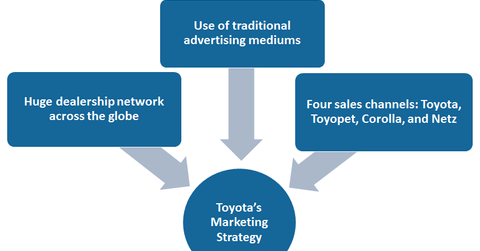Understanding Toyota’s Marketing Strategy
Toyota (TM) has become one of the top ten biggest advertising spenders in the US. The company spent 435 billion Japanese yen, or 1.6% of its revenues, on advertising and sales promotions during fiscal 2015.
June 14 2016, Updated 1:04 a.m. ET

Toyota Motor Corporation
Previously, we looked at how Toyota Motor Corporation’s (TM) production system helps the company to produce a huge number of vehicles with efficiency and minimized costs. Apart from minimizing costs, it’s also important for automakers to pay attention to their marketing strategy to meet the expectations of their customers.
In this part, we’ll explore Toyota’s marketing strategy.
Toyota’s marketing strategy
When Toyota was established, the company’s founder, Kiichiro Toyoda, viewed marketing as a critical tool to build a successful business. Shotaro Kamiya was the first president of Toyota Motor Sales Co., Ltd.
Kamiya’s stated, “The priority in receiving benefits from automobile sales should be in the order of the customer, then the car dealer and, lastly, the maker. This attitude is the best approach in winning the trust of customers and dealers and ultimately brings growth to the manufacturer.”
Dealers’ network and sales channels
On March 31, 2015, Toyota’s network consisted of 280 dealers, operating ~4,700 sales and service outlets in Japan. Out of these, 15 dealerships are owned by the company and the rest are independent.
Outside Japan, Toyota vehicles are sold through ~170 distributors in about 190 countries and regions. The company maintains networks of dealers through these distributors. As shown in the chart above, Toyota’s dealerships in Japan are divided into four sales channels: Toyota, Toyopet, Corolla, and Netz.
Advertising and promotion
Toyota (TM) has become one of the top ten biggest advertising spenders in the US. The company spent 435 billion Japanese yen, or 1.6% of its revenues, on advertising and sales promotions during fiscal 2015. These advertising and sales promotion activities primarily focus on traditional advertising channels, including print and electronic media, as well as outdoor advertising.
Among the other automakers (IYK), General Motors (GM) and Fiat Chrysler (FCAU) also allocate a huge budget for their traditional advertising expenses. In contrast, one of the world’s most valuable brands, Ferrari (RACE), doesn’t spend on traditional advertising channels. Instead, the company uses its racing team, Scuderia Ferrari, as a medium to promote its luxury brand.
Continue to the next article to see the recent trend in Toyota’s revenues.
